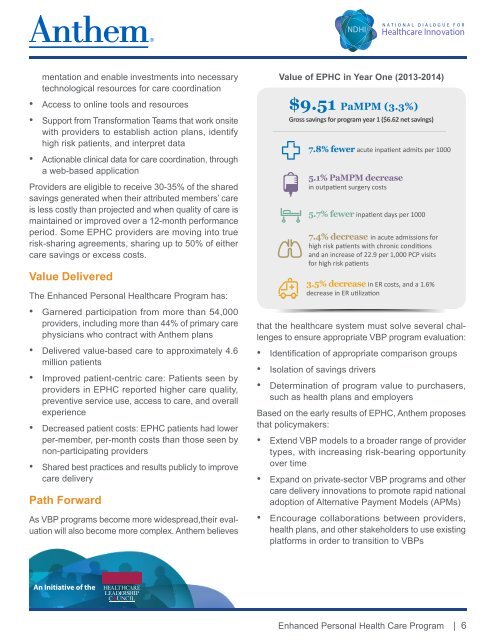VIable
HLCCompendium
HLCCompendium
Create successful ePaper yourself
Turn your PDF publications into a flip-book with our unique Google optimized e-Paper software.
NDHI<br />
NAT IONAL DIALOGUE FOR<br />
Healthcare Innovation<br />
mentation and enable investments into necessary<br />
technological resources for care coordination<br />
Value of EPHC in Year One (2013-2014)<br />
• Access to online tools and resources<br />
• Support from Transformation Teams that work onsite<br />
with providers to establish action plans, identify<br />
high risk patients, and interpret data<br />
• Actionable clinical data for care coordination, through<br />
a web-based application<br />
Providers are eligible to receive 30-35% of the shared<br />
savings generated when their attributed members’ care<br />
is less costly than projected and when quality of care is<br />
maintained or improved over a 12-month performance<br />
period. Some EPHC providers are moving into true<br />
risk-sharing agreements, sharing up to 50% of either<br />
care savings or excess costs.<br />
Value Delivered<br />
The Enhanced Personal Healthcare Program has:<br />
• Garnered participation from more than 54,000<br />
providers, including more than 44% of primary care<br />
physicians who contract with Anthem plans<br />
• Delivered value-based care to approximately 4.6<br />
million patients<br />
• Improved patient-centric care: Patients seen by<br />
providers in EPHC reported higher care quality,<br />
preventive service use, access to care, and overall<br />
experience<br />
• Decreased patient costs: EPHC patients had lower<br />
per-member, per-month costs than those seen by<br />
non-participating providers<br />
• Shared best practices and results publicly to improve<br />
care delivery<br />
Path Forward<br />
As VBP programs become more widespread,their evaluation<br />
will also become more complex. Anthem believes<br />
that the healthcare system must solve several challenges<br />
to ensure appropriate VBP program evaluation:<br />
• Identification of appropriate comparison groups<br />
• Isolation of savings drivers<br />
• Determination of program value to purchasers,<br />
such as health plans and employers<br />
Based on the early results of EPHC, Anthem proposes<br />
that policymakers:<br />
• Extend VBP models to a broader range of provider<br />
types, with increasing risk-bearing opportunity<br />
over time<br />
• Expand on private-sector VBP programs and other<br />
care delivery innovations to promote rapid national<br />
adoption of Alternative Payment Models (APMs)<br />
• Encourage collaborations between providers,<br />
health plans, and other stakeholders to use existing<br />
platforms in order to transition to VBPs<br />
Enhanced Personal Health Care Program<br />
| 6


